Home Safety Checklist For Manhattan
Keeping safe and secure in your residence should be your largest priority. But are you forgetting some key safety components? Look over this home safety checklist for Manhattan and find out where your home requires an update.
This guide begins with some whole-home safety items, and then we delve down room-by-room. Then, you can call (212) 553-6589 or send in the form below for additional information.
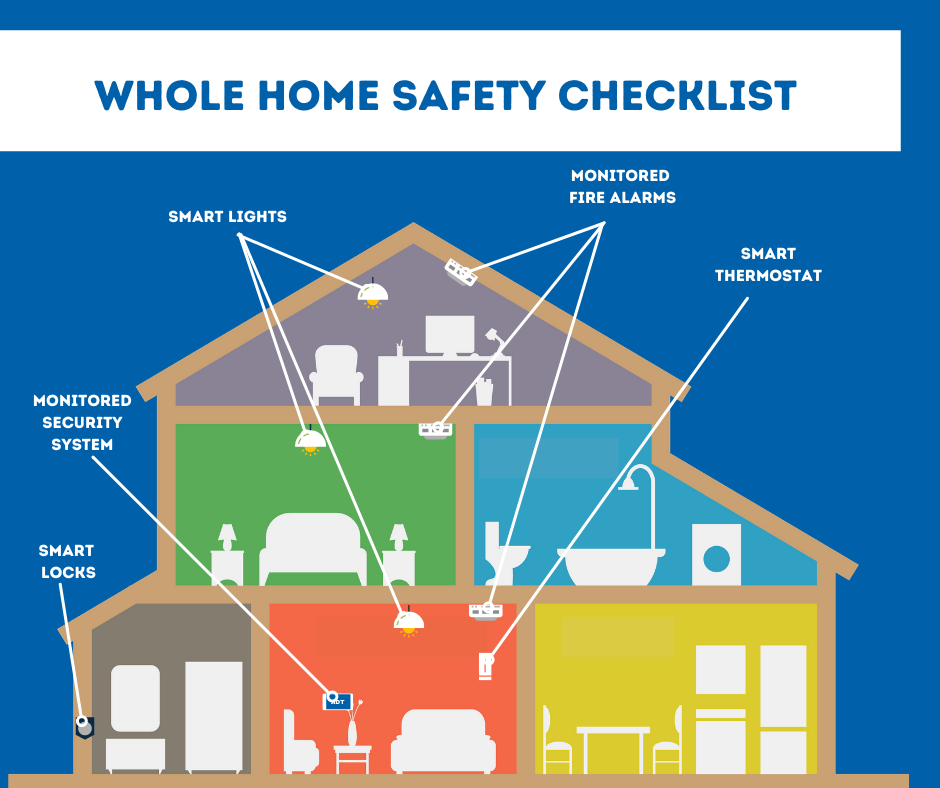
General Home Safety Checklist for Manhattan
While you will want to employ a individual room approach to home safety in Manhattan, there are a few things that work for a lot of your rooms. These items can sync to each other through a touchscreen hub, and oftentimes work off other components. You might also manage each of your home safety equipment through a smartphone app, such as ADT Control:
-
Monitored Home Security System: Each one of your entryways should have a sensor that alerts you to a break-in. When the alarm triggers, your monitoring expert responds to the alert and quickly contacts a first responder.
-
Smart Lights For Most Rooms: Of course, you can schedule your smart bulbs to make your house more efficient. But they can also allow you to remain safe during an emergency. Have your lights come on when a sensor trips to scare off burglars or light a path to a outside place.
-
Smart Thermostat: Likewise, a smart thermostat in Manhattan can save you between 10%-15% in gas and electric spending. Also, it can turn on an exhaust fan if you have a fire.
-
Monitored Fire Alarms: At the very least, you should have a fire alarm on each level of your house. You can improve your fire readiness by utilizing a monitored fire detector that senses unusual heat and smoke, and pings your 24-hour monitoring team when it thinks that there’s a fire.
-
Smart Locks: Every entryway that uses a keyed lock can be made safer with a smart lock. Now you can program codes to friends and family and receive texts to your phone when the locks are activated. Your locks can even automatically unlock, allowing you to quickly leave when you have a fire or other emergency.
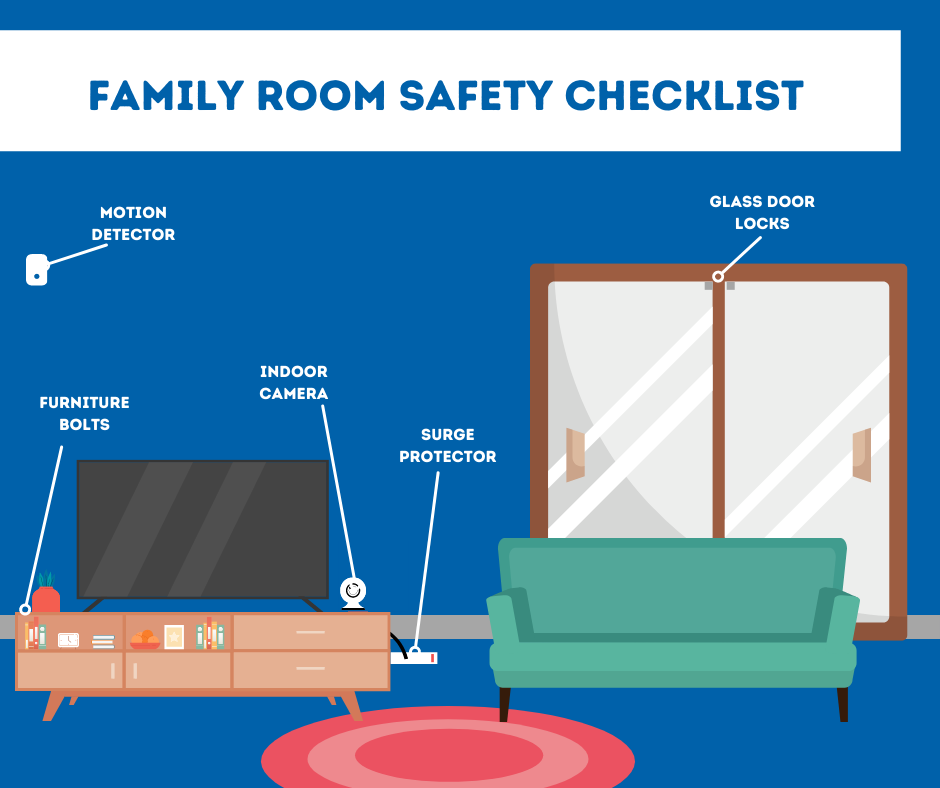
Family Room Safety Checklist For Manhattan
You’ll spend most of your time in your living room, so it’s the perfect place to start your home safety optimization. Electronics, like a TV or stereo system, probably are located in your living room, making it a popular room for robbers. Start with installing a motion detector or security camera in there, then try some of these ideas:
-
Motion Detectors: By putting in motion sensors, you’ll get a loud alarm if they sense suspicious motion in your living room. Look for motion detectors that filter out a dog or cat or you’ll have a tripped alarm every time your cat roams by for a midnight stroll.
-
Indoor Security Camera: An indoor security camera gives you a constant watch on your family room. Get constant streams of the area so you can know what’s going on from the mobile app. Or talk with your kids when they arrive home from school by using the two-way talk feature.
-
Surge Protector/Outlet Maintenance: Make sure you protect expensive electronics and stop overburdening your outlets with a surge protector. For additional comfort, set up a smart plug with surge protection included.
-
Entertainment Center Attached To The Wall: If you have curious kids, you’ll need to attach your heavy furniture and entertainment center to your wall. This is extra important if your living room uses carpeting that might make heavy objects extra wobbly.
-
Enhanced Locks For Sliding Doors: If your living room uses a sliding door that leads to a backyard, deck, or screened-in porch, you probably can see that the door lock is fairly thin. Put in a special lock, like a bottom bar or small locks that secures the door to the bottom and top of the frame.
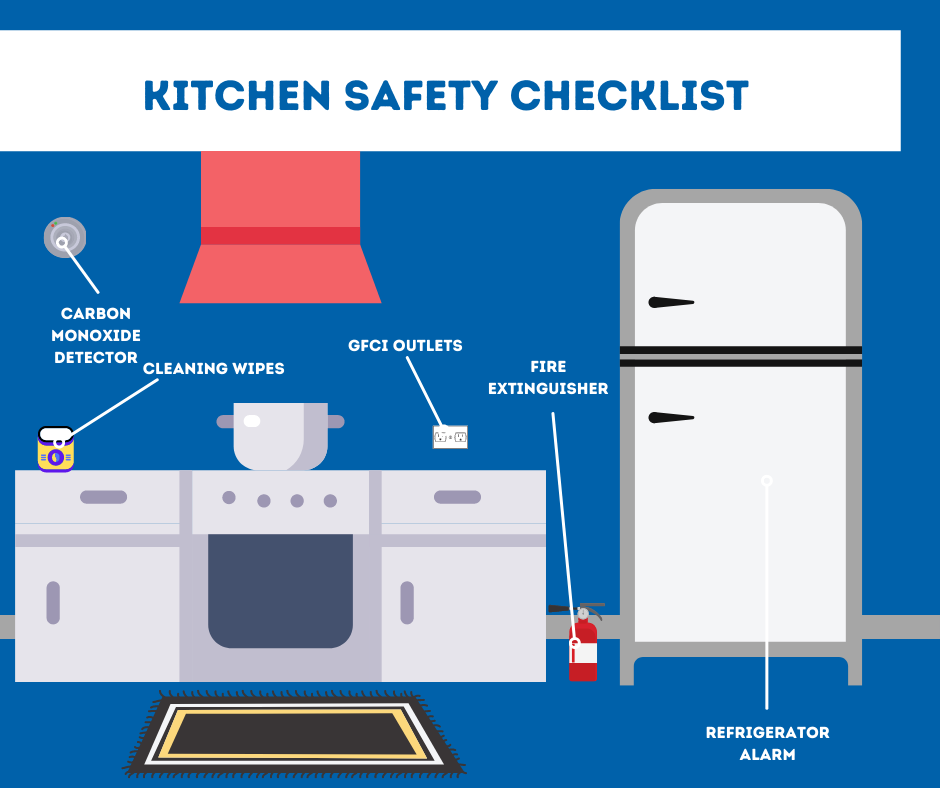
Kitchen Safety Checklist For Manhattan
Your kitchen has room for items that can add safety to your house. Some of these objects are also simple to add and can be bought from the grocery store:
-
Fire Extinguisher: Fire can come from from a neglected skillet or a towel that’s too close to a burner. Always keep a fire extinguisher at hand for any kitchen emergencies.
-
Circuit Interrupter Box On Each Outlet: A circuit interrupter outlet should be standard everywhere they’re close to running water to lessen the chance of electrocution. That includes the outlets around your sink and kitchen counter. Since 1987, it’s been standard to have one GFCI per dedicated circuit. But all your outlets will go dead if one outlet sees a surge, so you’re going to want to use a separate GFCI for every outlet.
-
Monitored Carbon Monoxide Detector: A carbon monoxide detector is advised for kitchens that have natural gas for the stove and oven. If your gas lines leak, the carbon monoxide detector will emit a loud, buzzing sound and contact your monitoring expert.
-
Clorox Wipes Or Spray: The biggest safety problem in the kitchen is the viruses, bacteria, and protein from blood from meat and dairy. Always have cleaning wipes or spray to sanitize your counters when preparing food.
-
Freezer and Refrigerator Alarm: The items in the fridge need to stay at a cold temperature to be safe to use. If you accidently leave the fridge or freezer door open too long, then a constant beep will let you know so you can check the seal. Some fridges already have this installed, others won’t, and you’ll have to buy a refrigerator alarm from the store.
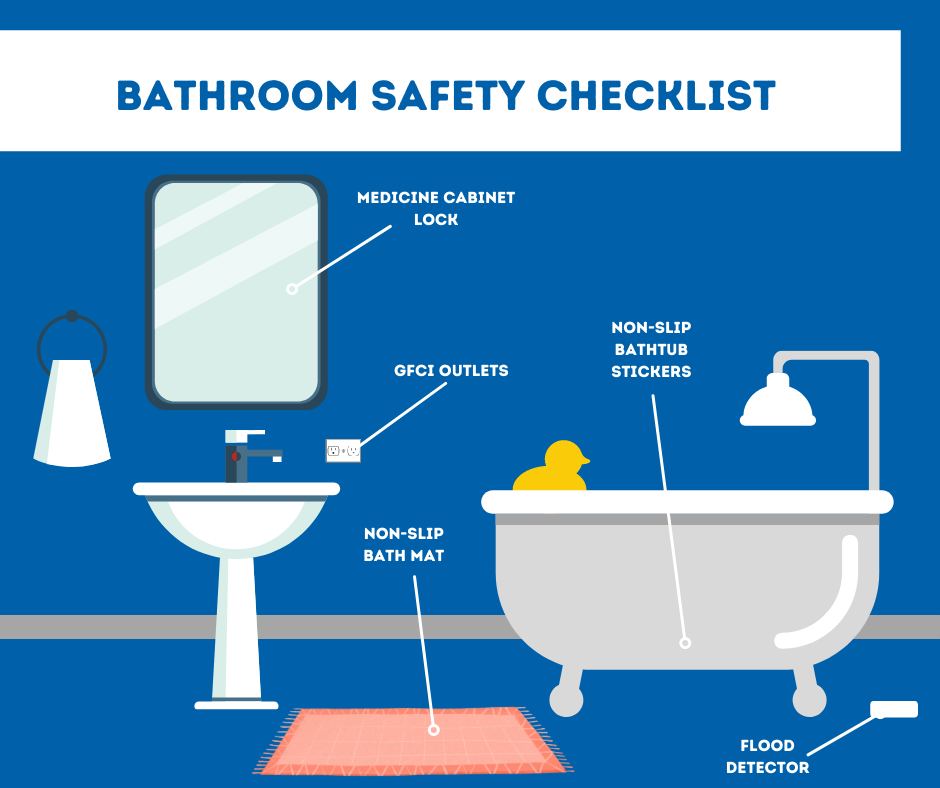
Bathroom Safety Checklist For Manhattan
Just because you don’t a lot of space in your bathroom there’s still safety hazards. From flood detectors to anti-surge outlets, here are five safety improvements for your bathroom:
-
Flood Detectors: A leaking sink or tub can lead to extensive damage. Find a leak with a flood detector and save yourself from redoing the whole bathroom.
-
No-slip Shower Mats: A slip and fall in the bathroom can be painful, causing bumps, bruises, or broken bones. Make sure you steer clear from these problems with a non-slip bath mat for after your bath or shower.
-
Textured Bathtub Stickies: Like a tiled floor, a bathtub can be a slippery surface to be on. Make sure every bathtub has some non-slip stickers so your toes have a textured patch for stability.
-
Medicine Door Latch: If you have little children or someone with memory difficulties, you have to take extra precautions regarding prescribed medicine. Safeguard your pills and syrups by using a medicine cabinet with a locking latch.
-
Circuit Interrupter Outlet: Similarly to the kitchen, you will have to also use a surge protecting GFCI outlet on every bathroom outlet. This will stop the flow of the electricity if they ever get wet or they experience a sudden jolt from a curling iron or hair dryer.
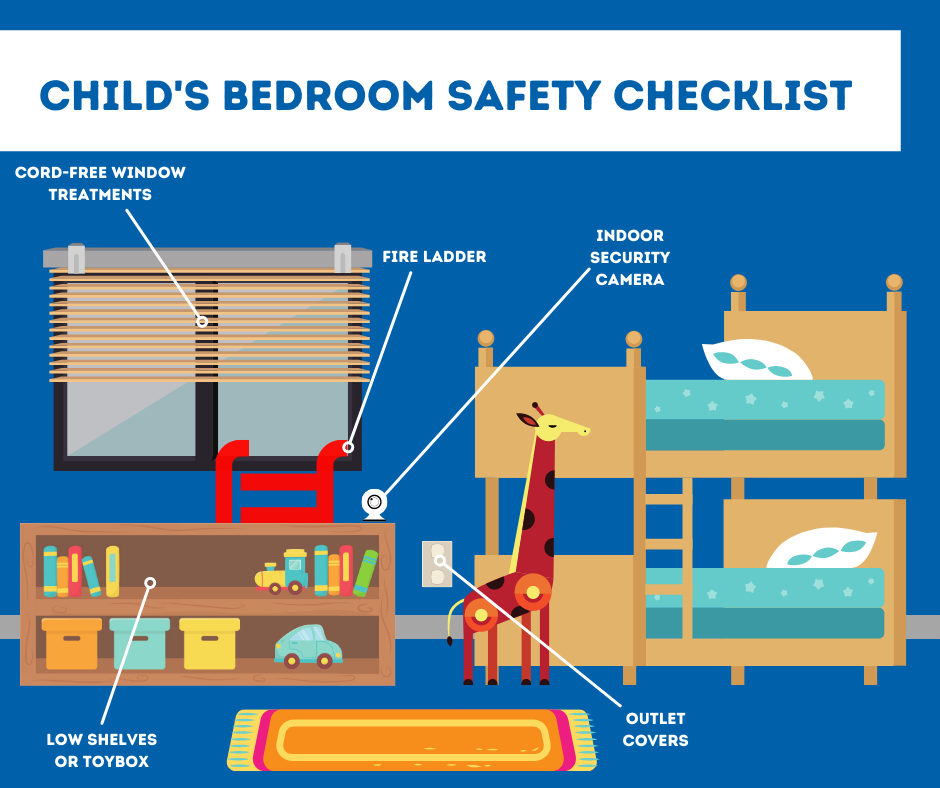
Kid’s Bedroom Safety Checklist For Manhattan
Your child’s bedroom should counterbalance safety with manageability. If their window treatments or other things are safe but difficult to use, then your child may perform dangerous methods -- like scale a chest of drawers -- to use them. Here are 5 easy, and safe, ideas:
-
Cord-Free Window Coverings: Safety professionals have identified window treatment cords a secret hazard for kids and pets. Install motorized treatments that your child can easily control via remote control. Or go state-of-the-art and connect your motorized coverings to your ADT smart hub so they open on a schedule at dawn, and go down at bedtime for added darkness.
-
Indoor Security Camera: A security camera sitting on your toddler’s dresser can behave as a baby monitor that you can watch with a smartphone. And if they want your help, they can push the two-way talk feature that comes with the camera.
-
Outlet Covers: While every outlet should have protective covers on them when you have small children, this is especially important in their bedroom. It’s the one place in your house where your child will most likely play by themselves without consistent additional supervision.
-
Window Fire Ladder: If you have bedrooms on the second story, then you will want to install a window fire ladder. These can help a child leave the house in case the hallway or lower levels are on fire. Remember to rehearse how to use the ladder a few times a year.
-
Toy Box Or Low Bookshelves: It’s interesting to view a toy chest as a safety component, but you’ll get it if you’ve ever tramped on a Lego in your stocking feet. A clutter-free floor let your child have a quick escape if there’s a fire or break-in.
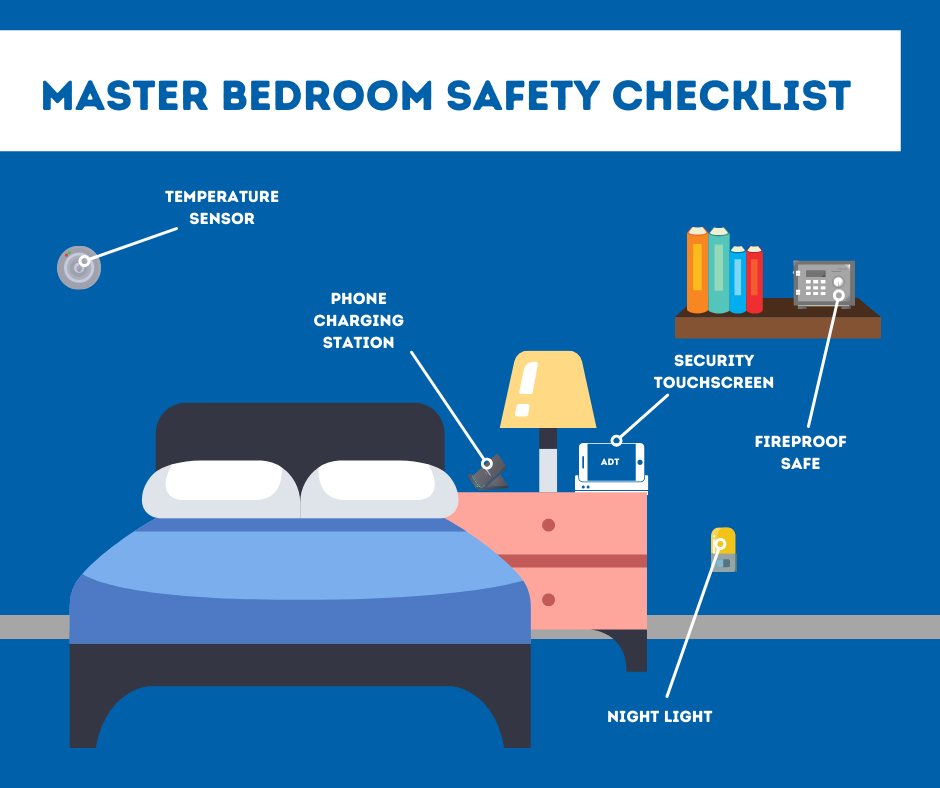
Master Bedroom Safety Checklist For Manhattan
Your master bedroom should be a refuge, so let your safety components make life easier if there's an emergency. After all, being wrenched awake by a high-decibel siren can be disorienting.
-
Security System Touchscreen: Having a smart hub on your nightstand gives you a sense of what’s going on without leaving your bed. You could alternatively turn on your ADT phone app. However, the large touchscreen is often easier to use to use when you’re bleary-eyed and confused.
-
Device Charging Stand: We use our smartphones for so much now alarm clocks, news readers, game machines, and sometimes even phones. However, a dead phone in the middle of the night cuts us off from communications if something goes wrong. To keep it nice and ready, a charging station or cord is an essential.
-
Nightlight/Smart Lights: A small light can be a beacon when you’re bolted awake from an alarm or unexpected noises. If you have trouble falling asleep with a small nightlight, put in a smart bulb in your fixtures. Then you can have light anytime with a push of a button or voice direction.
-
Fireproof Lockbox: Stash your essential documents like birth certificates, medical information, or a spare checkbook in a fireproof lockbox. This can be a big one that camps out in your closet or a slender portable safe that you can snatch on your way out during a fire or break-in.
-
Temperature Sensor: The drawback with bedrooms is that they can feel too stuffy or be cold since they are far from the thermostat. A temperature sensor will communicate to your smart thermostat so you can have a comfortable, peaceful sleep at the perfect climate.
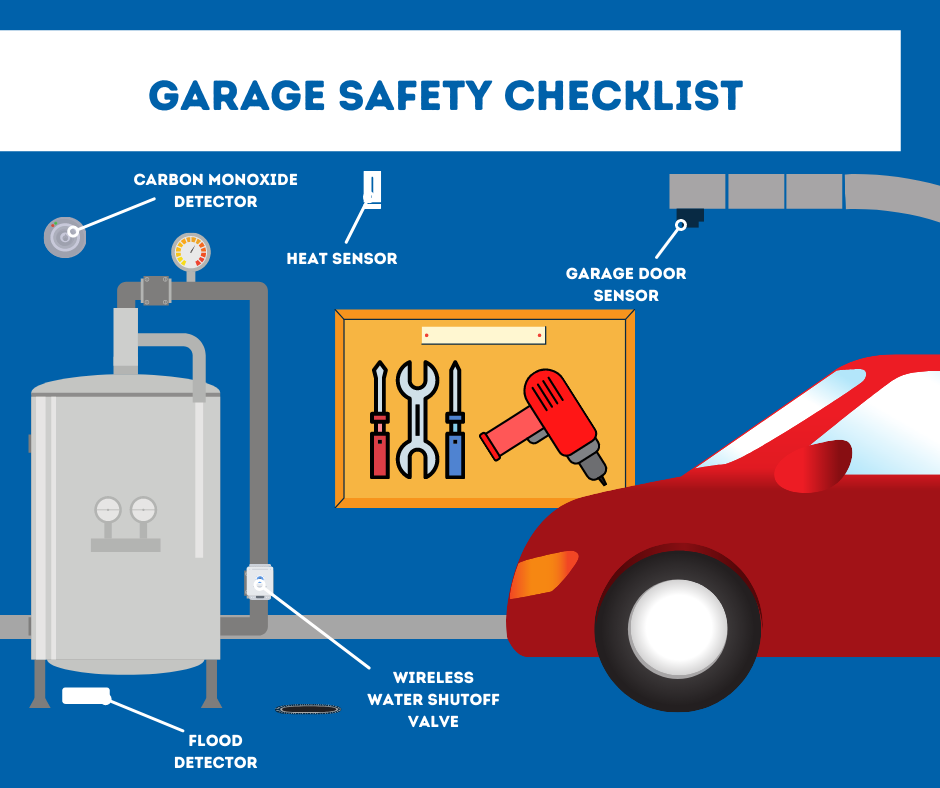
Garage/Basement Safety Checklist For Manhattan
Most safety problems in the basement or garage are with your water or furnace. Seeing issues before they start can prevent bigger problems later on. So, as you walk around your garage or basement, pay attention to these critical items:
-
Water Sensor Or Sump Pump Alarm: Putting a flood alarm by your water heater and sump pump can save you from finding a pond when you go into your basement or garage. It’s definitely better than sorting through a heap of destroyed storage boxes.
-
CO Detector: It’s beneficial to install a CO alarm in a place where a natural gas leak can occur. If you employ a gas furnace, try to hang an alarm in the same place as your unit.
-
Remote Water Shutoff Valve: If your flood alarm finds a hot water leak or a burst pipe, then you will have to cut off the primary water valve at once. With a remote shutoff valve, you can turn off your water flow from any mobile device. That’s helpful when you’re visiting relatives and see an emergency leak alert on your phone.
-
Garage Door Sensor: Leaving the garage door open causes all types of problems. You can lose HVAC energy through that gaping hole, and rodents or thieves can just wander in. A remote sensor will alert you to an open garage door and lets you lower it through the app.
-
Temperature Sensor: A temperature alarm in your garage or basement is essential if you worry about freezing pipes. The heat in these areas can be wildly different than your main rooms of the home, so you may want to maintain a constant look on the temp through your mobile app.
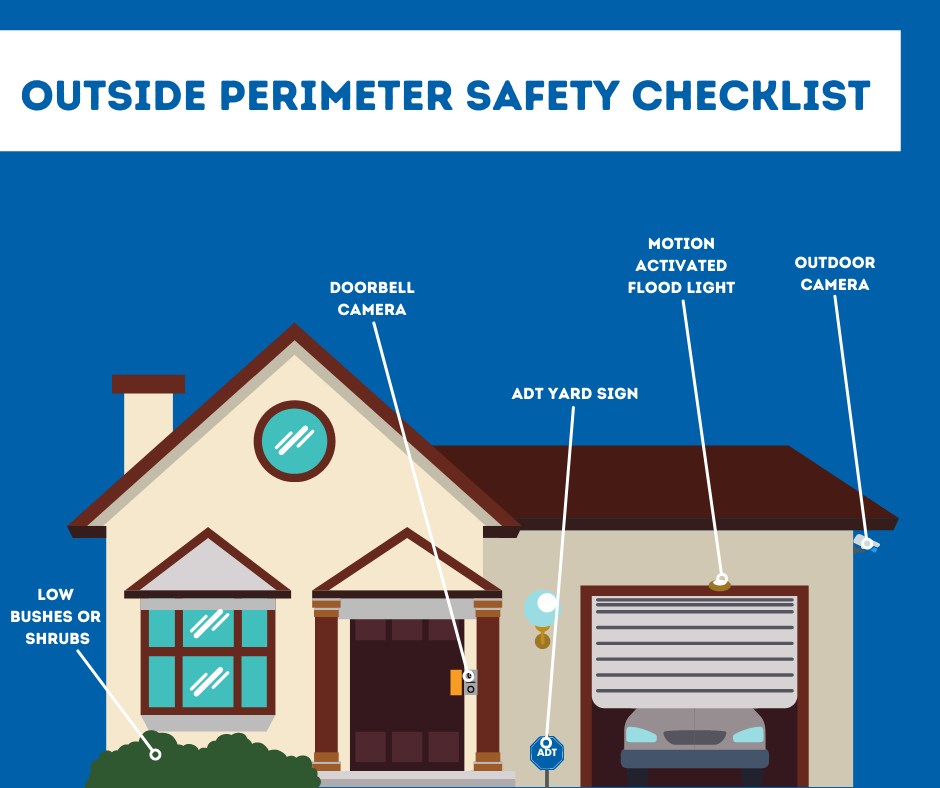
Outside Perimeter Safety Checklist for Manhattan
Your landscaping, drive, and front walk are just as crucial to make safe as the interior of your house. Try this checklist to make your outside safe:
-
Doorbell Security Camera: See who’s at the front door before you open it and talk to visitors. See package deliveries and review video clips if they are stolen.
-
Outdoor Security Camera: You can install outdoor cameras to alert you to suspicious movement in your yard. These security cameras are especially useful in areas where you may not have a window installed -- like a side yard or by the garage.
-
Low Bushes: Overgrown shrubs can give you some privacy, but they also obscure your line of sight of the yard. Don’t offer potential intruders an area to hide. Plus, large shrubs or foliage around your structure can clog gutters and bring in ants and termites.
-
ADT Signage: One of the biggest disincentives for a break-in is alerting aspiring rogues that you use a monitored ADT security system. An ADT yard sign by the main walk and a window sticker will show ne'er-do-wells that they ought to keep walking to an less prepared target.
-
Motion Triggered Outside Light Fixtures: Light is the largest deterrent to those who lurk in the dark. Motion-triggered lighting on your deck, porch, or garage can shoo possible intruders away. Lights also help you see the walk when you come to the house on those dark, winter nights.
Contact Secure24 Alarm Systems To Help Complete Your Home Safety Checklist for Manhattan
While Secure24 Alarm Systems can’t help you with each household item on your Manhattan home safety checklist, we can offer a powerful security system. With everything from alarms to thermostats, we can personalize the best system for your family’s needs. Just call (212) 553-6589 and talk to a professional or fill out the form below. Or customize your own system with our Security System Designer.
